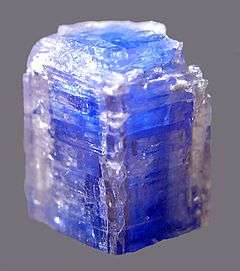Carletonite
| Carletonite | |
|---|---|
|
| |
| General | |
| Category | Phyllosilicate |
| Formula (repeating unit) | KNa4Ca4(CO3)4Si8O18(F,OH)·(H2O) |
| Strunz classification | 09.EB.20 |
| Crystal system | Tetragonal |
| Space group | Tetragonal ditetragonal dipyramidal H–M symbol (4/m 2/m 2/m) |
| Unit cell | a = 13.17 Å, c = 16.69 Å; Z = 4 |
| Identification | |
| Colour | Colourless, light blue, dark blue, or pink |
| Crystal habit | Prismatic crystals, massive |
| Cleavage | Perfect on {001}, good on {110} |
| Fracture | Conchoidal |
| Tenacity | Brittle |
| Mohs scale hardness | 4 - 4½ |
| Lustre | Vitreous |
| Streak | White |
| Diaphaneity | Transparent to translucent |
| Specific gravity | 2.45 |
| Optical properties | Uniaxial (-) |
| Refractive index | nω = 1.521 nε = 1.517 |
| Birefringence | δ = 0.004 |
| Pleochroism | Weak; O = pale blue; E = pale pinkish brown |
| References | [1][2][3] |
Carletonite is a rare silicate mineral with formula KNa4Ca4(CO3)4Si8O18(F,OH)·(H2O).
It is a phyllosilicate and a member of the apophyllite group. Its tetragonal crystals are a translucent blue, white, colorless or pink with a vitreous to dull lustre. It has a density of 2.45 and a hardness of 4-4.5.
It is named after Carleton University, in Ottawa, Ontario. It was first described in 1969 for an occurrence at Mont Saint-Hilaire, Quebec. The type locality at Mont Saint–Hilaire is the only reported occurrence.[1][2] It occurs in hornfels and siliceous marble xenoliths within and adjacent to a nepheline syenite intrusion. It occurs in association with quartz, narsarsukite, calcite, fluorite, ancylite, molybdenite, leucosphenite, lorenzenite, galena, albite, pectolite, apophyllite, leifite, microcline and arfvedsonite.[1]
References
| Wikimedia Commons has media related to Carletonite. |
